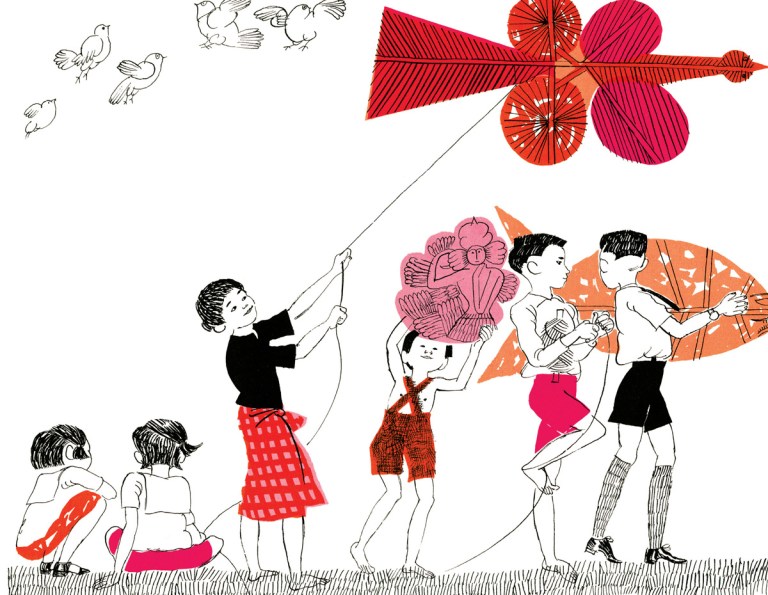“In a sunny, sleepy place halfway around the world in Siam, on the banks of a long brown river, there once lived a little boy whose name was Nu Dang.”
In the late 1950s, the Jamaican-American illustrator and designer Jacqueline Ayer(May 2, 1930–May 20, 2012) moved halfway around the world to present-day Thailand, then Siam, to expand her already pioneering creative career and start a family. Ayer had grown up alongside the great graphic designer Milton Glaser at the “Coops” — the first interracial housing in the United States, a communist-inspired cooperative for garment workers in the Bronx. After graduating from Harlem’s iconic public High School of Music & Art, she attained a degree in fine art from Syracuse University and continued her studies in Paris, where her work attracted the attention of Christian Dior and got her editorial appointments for Vogue magazine. In Paris, she fell in love with a young American man who had just returned from Burma and who ignited in her a passion for the cultures of the Far East.
Not yet thirty, Ayer moved to Bangkok with her new husband, where they raised their two daughters and she launched a fashion company using traditional Thai craftsmanship to print her vibrant designs onto silk and cotton. Her fabrics made their way into New York and London’s glamorous department stores, and she went on to help Indira Gandhi’s government develop India’s traditional textile crafts.
Before the apogee of the civil rights movement, before the second wave of feminism, before globalization as we know it today, Jacqueline Ayer became a successful creative entrepreneur in a faraway land and a champion of the arts as a force of empowerment.
While living in Thailand, Ayer began writing and illustrating a series of children’s books celebrating the values and sensibilities of the local culture while exploring the most universal themes of human experience — heartbreak, hope, the power of the imagination to transform and redeem. These uncommonly poetic, stunningly illustrated treasures, The Paper-Flower Tree among them, earned Ayer the 1961 Gold Medal of the Society of Illustrators, considered the Academy Award of illustration — a landmark achievement for women and artists of color.
The series began with Nu Dang and His Kite (public library), originally published in 1959 and reissued for the first time nearly six decades later by Brooklyn-based independent powerhouse Enchanted Lion.
Ayer’s lovely, lyrical prose spills from her beautifully illustrated pages to the tell the transportive story of a little boy — “the happiest boy in the world” — and his beloved kite, a story of loss, hope, and homecoming.
In a sunny, sleepy place halfway around the world in Siam, on the banks of a long brown river, there once lived a little boy whose name was Nu Dang.
He loved more than anything else — more than swimming in the cool river on a hot day, more than orange ice, even more than two orange ices — most and best Nu Dang loved to fly his kite.
Whenever the day was right for kites — when the wind was strong, the sky clear, and the sun shining brightly — Nu Dang and his friends would come with their kites to a grassy field.
Nu Dang’s kite was the boldest and the bravest of them all. It ran swiftly with the wind and chased the birds that flew around the sun.
Nu Dang was the happiest boy in the grassy field.
He was the happiest boy in Siam.
He was the happiest boy in the world.
But this soaring bliss plummets into heartbreak one windy day when Nu Dang’s kite slips out of his hand — “just like that!” — and disappears into the clear blue skies, leaving the little boy bereft.
He climbs onto his small boat on the river and sits quietly for a while, reminiscing about his brave, beautiful, irreplaceable kite.
Unwilling to lose hope, Nu Dang sets off to find his vanished joy.
Paddling down the wide brown river, he asks everyone he encounters whether they have seen his kite — the vendor of sweet cakes, the boatman hauling a pile of fresh hay for his oxen, the young monks he greets with a bow, the bustling crowds of the “Floating Market.”

Everyone was brisk and busy and had no time for a small boy with questions about a kite.
Still, he asked everyone: the vendor of lotus and jasmine, and the vendor of curry sauce and chilies. He asked the pineapple, pomelo, and papaya boat; the chickpea-green bean boat; the “all kinds of fresh fish” boat. And they all said, “No!” They hadn’t seen his kite.
On and on he goes along the river, stopping by restaurants and shops and farmhouses, asking everyone and receiving the same disheartening answer, until he finally arrives home, crestfallen and vacant of hope.
And then, with disbelieving elation, Nu Dang discovers his kite bobbing gently on the ground by his own house, deposited by the day’s downstream wind — a touching testament to John Steinbeck’s conviction that “nothing good gets away.”
Complement Nu Dang and His Kite with The Blue Songbird — a kindred parable of homecoming also inspired by Asian aesthetics — then revisit other Enchanted Lion gems: Jerome by Heart, Big Wolf & Little Wolf, Cry, Heart, But Never Break, The Lion and the Bird, and Bertolt.
Illustrations courtesy of Enchanted Lion Books; photographs by Maria Popova






















